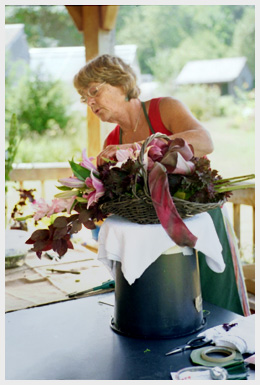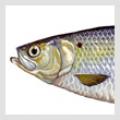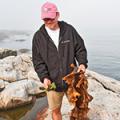Getting the Most Out of Cut Flowers
By Lynette L. Walther
 Red and yellow mums. Photo: Lynette L. WaltherSearsport resident Anna Kessler knows her cut flowers. She is a flower arrangement judge for the Garden Club of America and teaches the art to garden clubs and other organizations. During a recent demonstration at Merryspring Nature Park, in Camden, Maine, she showed participants how to arrange a variety of flowers for various occasions, and how to prolong the blooms’ vase life.
Red and yellow mums. Photo: Lynette L. WaltherSearsport resident Anna Kessler knows her cut flowers. She is a flower arrangement judge for the Garden Club of America and teaches the art to garden clubs and other organizations. During a recent demonstration at Merryspring Nature Park, in Camden, Maine, she showed participants how to arrange a variety of flowers for various occasions, and how to prolong the blooms’ vase life.
 Anna Kessler arranges a basket of
Anna Kessler arranges a basket of
flowers during a presentation at
Merryspring Nature Center in Camden.
Kessler offered advice on extending
vase life of cut flowers and
creating pleasing arrangements.
Photo: Lynette L. WaltherKessler said that vase-life of arrangements can be extended whether the flowers are from your own cutting garden or purchased from a grocery store or florist. When working with flowers, sharp tools are important to avoid crushing stems. Cuts at an angle help increase surface area for water absorption and prevent stems from sitting flush on the bottom of the container.
One of the most important things one can do to already-cut flowers is to re-cut the stems under water. The cut should be made just above a leaf node or new bud. Place the flower stems in a bucket of water or other large container, then cut a short portion of the bottom of the stem while it is under the water to help the stem draw up moisture.
“This prevents air bubbles getting up the stem and blocking off the water supply to the flower or foliage,” Kessler said. She also recommended removal of any foliage that will be under the water line in the vase.
Speaking of water, rainwater is the best choice for arrangements. “Never use water from a softening system,” Kessler advised, adding that distilled water is “robbed of everything,” and not a wise choice either.
She suggested using a floral preservative solution for most cut flowers. “It provides food and keeps the water bacteria-free.” A home-made preservative solution can be concocted by adding one teaspoon each of bleach and sugar and two teaspoons of lemon juice to one quart of water. Citrus-based soda can be used instead of the sugar and lemon juice.
Floral preservatives should never be used in silver or other metal vases, because they can pit the surface. To avoid that problem, Kessler suggested using plastic liners in all metal containers.
“Virtually anything that can be made to hold water and is waterproof may be used,” Kessler said of container possibilities. “Just remember to match the container to the flowers. For example, marigolds would be better in a basket or earthenware container than in a crystal bud vase or a silver rose bowl.”
All containers used for conditioning and displaying flowers should be kept scrupulously clean. Tools and containers should be scrubbed with hot water, detergent, and a bleach solution after each use, then rinsed. Florist's foam should not be reused because of possible bacterial contamination.
Floral arrangements will last longer if refrigerated overnight and kept out of dry, heated areas. Many will benefit from an occasional spritz of fresh water.
“Keep all arrangements away from drafts, direct sunlight, heat vents, and ripe fresh fruit and vegetables,” Kessler said. The latter give off ethylene gas and hasten the decay of all plant material. Kessler added, “Re-cut stems, clean the container, and change the water every other day.”
One of Kessler’s tricks for colorful arrangements is to use a drop or two of food coloring in the water of a clear glass vase to give additional color and contrast.
Kessler cited the principles of balance, proportion, scale, rhythm, dominance, contrast, harmony, and unity as elements of pleasing floral arrangements. Color, form, line, size, space, texture, and pattern are the “ingredients” of a floral design. She suggested that experimentation is one of the best ways to create your own flower arrangements.
“Use your imagination, learn a few basic principles, and you will be amazed at your own creativity,” she concluded.

 Red and yellow mums. Photo: Lynette L. Walther
Red and yellow mums. Photo: Lynette L. Walther Anna Kessler arranges a basket of
Anna Kessler arranges a basket offlowers during a presentation at
Merryspring Nature Center in Camden.
Kessler offered advice on extending
vase life of cut flowers and
creating pleasing arrangements.
Photo: Lynette L. Walther

Contributing Garden Editor Lynette L. Walther is the recipient of the National Garden Bureau’s Exemplary Journalism Award and the IABC Silver Quill Award of Excellence. She is a member of the Garden Writers Association. She gardens in Camden.
Related Articles
Share this article:
2023 Maine Boat & Home Show

Join Us for the Maine Boat & Home Show!
Art, Artisans, Food, Fun & Boats, Boats, Boats
August 11 - 13, 2023 | On the waterfront, Rockland, Maine
Click here to pre-order your tickets.
Show is produced by Maine Boats, Homes & Harbors magazine.















